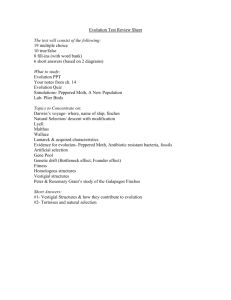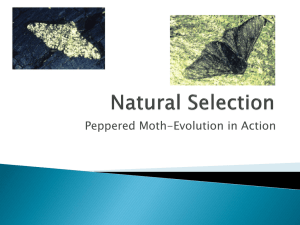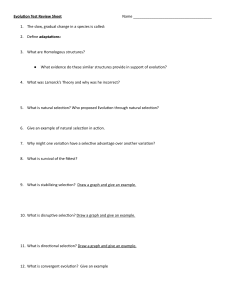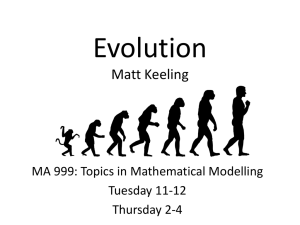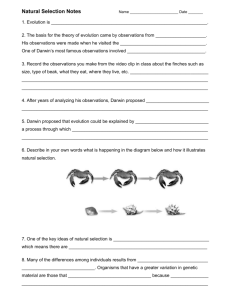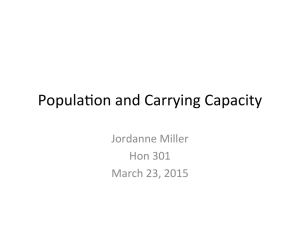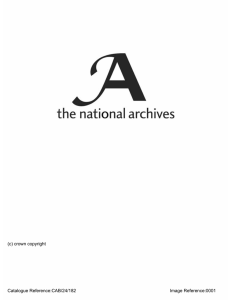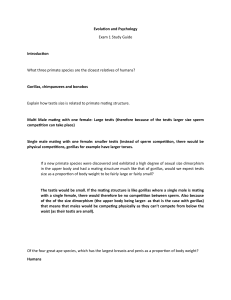Document 13330145
advertisement
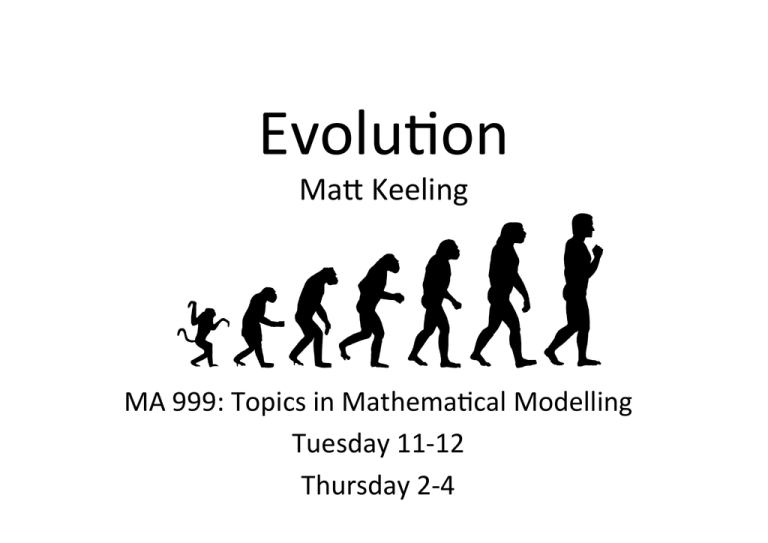
Evolu&on Ma+ Keeling MA 999: Topics in Mathema&cal Modelling Tuesday 11-­‐12 Thursday 2-­‐4 Evolu&on Lecture 1 Tuesday 6th 11-­‐12 Introduc)on. Evidence for evolu&on. Fitness. Compe&&on. Lecture 2 Thursday 8th 2-­‐3 Games & Genes. Lecture 3 Thursday 8th 3-­‐4 Computer-­‐based prac)cals – example programs and ques&ons. Lecture 4 Tuesday 13th 11-­‐12 Sex and Specia)on. Sexual selec&on. Males as parasites. Why sexual reproduc&on? How do new species arise. Lecture 5 Thursday 15th 2-­‐3 Disease evolu)on. Why aren’t we all wiped out by killer infec&ons? Lecture 6 Thursday 15th 3-­‐4 Computer-­‐based prac)cals – example programs and ques&ons. Charles Robert Darwin (1809 – 1882) “On the Origin of Species” 1859 Charles Robert Darwin (1809 – 1882) “On the Origin of Species” 1859 I think Case must be that one genera&on then should be as many living as now. To do this & to have many species in same genus (as is) requires ex&nc&on. Thus between A & B immense gap of rela&on. C & B the finest grada&on, B & D rather greater dis&nc&on. Thus genera would be formed. — bearing rela&on to ancient types with several ex&nct forms... We s&ll use such a “Tree of Life” today. However, one has to be very careful about its shape and the implica&ons of being “at the top”. Its very easy to see this as saying that humans and apes are be2er than monkeys, and all mammals are be2er than rep&les. This is not true – the only real meaning of be2er is a measure of evolu&onary fitness; and as we’ll see later this is a complex concept. Evidence for Evolu)on: observa)on Darwin’s Ground Finches Evidence for Evolu)on: observa)on Darwin’s Ground Finches Peppered Moth Due to pollu&on leading to darker environments, the wild-­‐type (white) Peppered Moth is being replaced by mutant (black) variety. Evidence for Evolu)on: breeding Darwin’s Ground Finches Peppered Moth Pigeon breeding Evidence for Evolu)on: breeding Darwin’s Ground Finches Peppered Moth Pigeon breeding Dog breeding Evidence for Evolu)on: Lab experiments Darwin’s Ground Finches Peppered Moth Pigeon breeding Dog breeding E.coli in the lab (Richard Lenski) 50,000 genera&on of E.coli bacteria in lab popula&ons. One of the popula&ons evolves to exploit critrate in the growth medium, leading to faster growth. Increased fitness of all popula&ons; 70% faster growth than the ancestor. Evidence for Evolu)on: Lab experiments Darwin’s Ground Finches Peppered Moth Pigeon breeding Dog breeding E.coli in the lab (Richard Lenski) Fruit flies in the lab (Michael Rose) Popula&ons of fruit flies are selected for late reproduc&on, leading to longer lived individuals. Evidence for Evolu)on: Phylogene)cs Darwin’s Ground Finches Peppered Moth Pigeon breeding Dog breeding E.coli in the lab (Richard Lenski) Fruit flies in the lab (Michael Rose) Modern Phylogene)cs By examining gene&c similarly we are able to generate evolu&onary trees linking modern species to common ancestors. Evidence for Evolu)on: Phylogene)cs Darwin’s Ground Finches Peppered Moth Pigeon breeding Dog breeding E.coli in the lab (Richard Lenski) Fruit flies in the lab (Michael Rose) Modern Phylogene)cs By examining gene&c similarly we are able to generate evolu&onary trees linking modern species to common ancestors. Modelling Evolu)on: Fitness Fitness is the fundamental concept in evolu&onary theory. Despite us all having a general idea of what fitness is, its defini&on is complex. Fitness is all about expected reproduc&ve poten&al It is a func&on of both the individual and the environment, and necessarily includes integrals over &me. Fitness (organism | environment) = E(number of successful offspring) Low Fitness High Fitness Modelling Evolu)on: Compe))on The power-­‐house of evolu&onary modelling is compe&&on between species / variants / muta&ons. Here I’ll illustrate the dynamics using the famous / familiar Lotka-­‐Volterra Predator-­‐Prey model. Modelling Evolu)on: Compe))on There are two basic forms of model: The first starts with a wild-­‐type popula&on (at equilibrium), adds a small amount of a mutant, and allows the two popula&ons to compete. This can be examined mathema&cally. The second also starts with a wild-­‐type popula&on (at equilibrium) but allows muta&on at every step of the process. This can only really be examined numerically, using PDEs or simula&on. Modelling Evolu)on: Compe))on For two-­‐species compe&&on we generally find that which-­‐ever species can persist in the worst environment wins.

